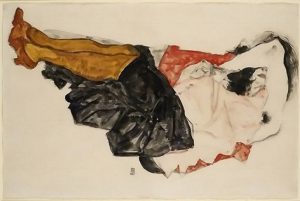Finden Sie die deutsche Übersetzung hier
Austria / Czech Republic / United States
Who really owns a drawing by the Austrian expressionist Egon Schiele?
Daniel Wise
New York Law Journal
September 07, 2010

Egon Schiele, Self Portrait 1914
The heirs of an art collector who perished in a Nazi concentration camp have been given another chance to establish their claim that a drawing by the Austrian expressionist Egon Schiele was stolen from their family.
The 2nd U.S. Circuit Court of Appeals last week ruled in Bakalar v. Vavra, 08-5119-cv, that Southern District Judge William H. Pauley erred in applying Swiss law as opposed to New York law in determining ownership of the work.
The panel’s ruling vacates Pauley’s finding that David Bakalar, an American art collector, became the rightful owner of “Woman Seated with Bent Left Leg (Torso)” when he bought the drawing from a New York gallery in 1963 for $4,300.
The New York gallery had acquired the black crayon and water-based paint drawing four months earlier from a Swiss gallery. In 2004, Bakalar sold the drawing at an auction conducted by Sotheby’s in London for $675,000.
Sotheby’s put the sale on hold after the heirs to Austrian art collector and cabaret performer Franz Friedrich “Fritz” Grunbaum stepped forward to claim ownership of the piece. Grunbaum was arrested by the Nazis as he fled Vienna in 1938 and died at Dachau in 1941.
The two heirs, Czech citizen Milos Vavra and New York resident Leon Fischer, traded lawsuits with Bakalar in 2005, with both sides seeking to be declared the rightful owner.
In declaring Bakalar to be the owner, Judge Pauley applied Swiss law, under which Bakalar, as a good-faith buyer, would acquire title to the work after five years without a claim being asserted, even if the drawing had been stolen.
New York law on the issue is very different: under no circumstances can a thief pass good title and a person from whom property was stolen has a claim superior to a good faith purchaser.
Writing for the circuit, Judge Edward R. Korman, sitting by designation from the Eastern District of New York, concluded that Pauley had relied on the wrong test in choosing to apply Swiss law. The panel remanded the case to Pauley for further proceedings, and, “if necessary, a new trial.”
Korman also wrote a concurring opinion, questioning Pauley’s finding that the Grunbaum heirs failed to produce “any concrete evidence that the Nazis looted the drawing.”
Korman wrote that his reading of the record suggests to the contrary that Grunbaum was “divested of possession and title [of the drawing] against his will.”
Judges Jose A. Cabranes and Debra Ann Livingston joined in Judge Korman’s main ruling.
Provenance in Dispute
The question of whether the Schiele drawing was stolen by the Nazis is sharply disputed.
Bakalar contends Grunbaum’s sister-in-law sold the drawing along with 45 other Schiele works in 1956 to a Swiss art gallery, Galerie Gutekunst. That claim is backed up by documents in files maintained by the Swiss gallery, which show “beyond rational dispute” that the sister-in-law, Mathilde Lukacs, was the seller, said Bakalar’s lawyer, James A. Janowitz, of Pryor Cashman.
The lawyer for the heirs, Raymond Dowd of Dunnington, Barthlow & Miller, called Bakalar’s claims “a complete fabrication based upon forged documents.”
About four months after the Galerie Gutekunst acquired the drawing, it sold it to the Galerie St. Etienne in New York, which seven years later sold it to Mr. Bakalar.
Korman said Pauley should have considered which jurisdiction had the greatest interest in the case.
New York has a “compelling interest” preserving the integrity of its art market as its state Court of Appeals has stated on several occasions, Korman wrote. For instance, in Guggenheim Foundation v. Lubell, 77 N.Y.2d 311 (1991), former Chief Judge Sol Wachtler wrote for a unanimous Court, “New York enjoys a worldwide reputation as a preeminent cultural center. To place the burden of locating stolen artwork on the true owner…would, we believe, encourage illicit trafficking in stolen art.”
By comparison, Korman described the Swiss interest as being “tenuous.” Application of New York law might cause New Yorkers to take a closer look at the work’s provenance, and that in turn, he reasoned, “might adversely affect the extra-territorial sales of artwork by Swiss galleries.”
For choice of law purposes, that Swiss interest, he concluded, must give way to New York’s “significantly greater interest” in preventing the state “from becoming a marketplace for stolen goods.”
On the question of Bakalar’s ownership, Korman noted that the record indicated that Grunbaum was forced to execute a power of attorney giving his wife control of his artwork four months after he was arrested by the Nazis and imprisoned at Dachau.
Under Uniform Commercial Code §2-403(1), which has been adopted in New York, status as a good faith buyer only attaches if a transfer of property is “voluntary,” he wrote.
In Grunbaum’s case, the circumstances “strongly suggest he executed the power of attorney with a gun to his head,” Korman said. If that was so, he wrote, under New York law “any subsequent transfer was void.”
“[Mr.] Bakalar’s suggestion that the power of attorney constituted a voluntary entrustment to property to [Mr. Grunbaum’s] wife is a proposition that remains for him to prove.”
“Unless he does so,” Korman added, even if Grunbaum’s wife, Elizabeth, transferred ownership to her sister to prevent the work from falling into the hands of the Nazis “she could not convey valid title to the artwork.”


 Egon Schiele, Self Portrait 1914
Egon Schiele, Self Portrait 1914

